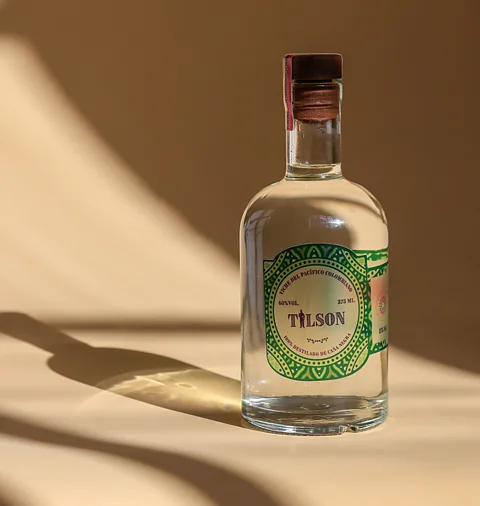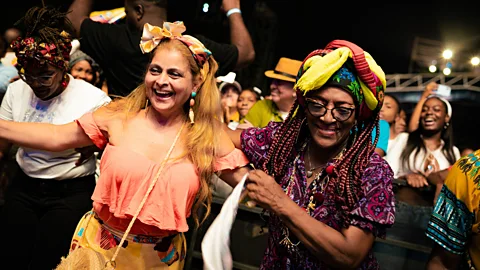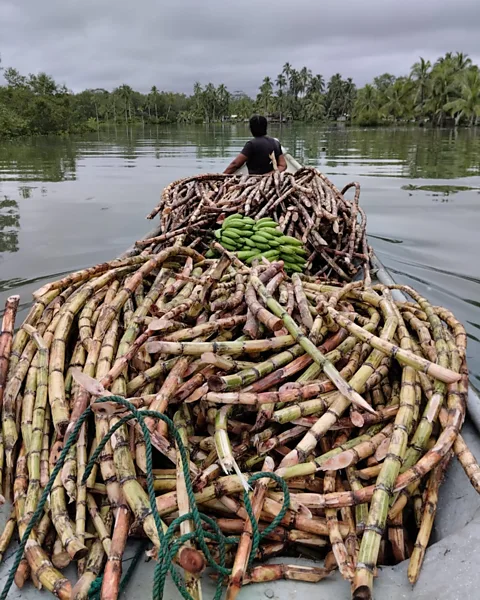A spirit so good people are smuggling it in suitcases
 Claire McQue
Claire McQueStrong, sweet and steeped in history, viche could become to Colombia what mezcal is to Mexico. But Afro-Colombians are having to fight to save it from cultural appropriation.
Colombia's south-west is a wild region festooned with silvery rivers that disgorge into the Pacific Ocean. Only two main roads snake through emerald rainforest towards the coast. The Afro-Colombians – black Colombians descended from enslaved people – who have lived here for centuries rely instead on boats to get around. These communities are among the country's poorest, lacking infrastructure, state support and economic opportunities. And yet, they are the guardians of an ancestral tradition that is on the verge of becoming Colombia's national alcohol.
Viche (sometimes called "biche") is a strong, sweet liquor that Afro-Colombians distil from four types of sugarcane (yellow, black, morada and pataperro) that spring up to 7m high on small plots of land sandwiched between rainforest, mangroves and rivers.
"Viche comes from Africa, brought from our Bantu ancestors when they were enslaved in rivers around the Colombian Pacific," said José Tilson Arroyo Valencia. One of Colombia's most respected vicheros (producers), he has been crafting the liquor for more than 30 years on the banks of the Cajambre River, three hours from the port city of Buenaventura.
"Viche is present from birth until death," added Rosmilda Quiñones Fajardo who represents the Association of United Midwives of the Pacific, noting that it is far more than just a drink for her community. Each sip distils ancient traditions: it is imbibed to aid fertility, baptise children, mark deaths, cure colds or to increase energy. Rosmilda has been using "el patrón" – as she calls viche – in traditional midwifery for more than four decades. She administers viche to mothers every 40 days after giving birth; to fortify them while breastfeeding; or combines the liquor with medicinal plants to relieve menstrual cramps.
"[It] relates to the spiritual life of each person", she said. "Without viche, there is nothing."
 La Vichería
La VicheríaAlthough men can be vicheros, it is predominantly women who keep the tradition alive. Rogelia Quiñonez Caicedo, now 61, was 10 years old when her grandmother taught her to cut sugarcane in Vereda Silva on the Cajambre River. Together they'd crush the cane, often on community-owned trapiches (sugar mills), then the juice, or guarapo, would be cooked and left to ferment naturally, sometimes in wooden barrels, for up to 20 days in the hot, humid conditions.
Once distilled, the final product puts hairs on your chest: viche puro can be anywhere between 31% and 51% alcohol. Rogelia's viche, which she sells as the brand Doña Sofi (Madame Sofi), clocks in at 40%.
Women known as transformadores (transformers) then infuse potent herbs such as pipilongo, a fiery pepper native to the Pacific region, and cimarrón, a type of strong-tasting coriander, to make medicinal drink known as curado (cured alcohol).
WORLD'S TABLE
BBC.com's World's Table "smashes the kitchen ceiling" by changing the way the world thinks about food, through the past, present and future.
The exact herbal concoction is "the secret of the vichera", says Mamá Orbe, a vichera and community leader. She makes hers on a traditional wooden trapiche beneath papaya trees on her family's farm near the town of El Valle in the region of Chocó.
No single viche tastes the same. Much like wine or coffee, the terroir where the cane grows determines the flavour. It may be herbal, piquant or reveal notes of caramel, slipping down the throat and leaving just a warm glow on the lips. Some producers may also macerate indigenous ingredients such as coca leaves and vanilla.
 Fundación Acua
Fundación AcuaWhile viche was once only known within Afro-Colombian communities, the drink is now booming throughout Colombia, spurred by the country's influential chefs and mixologists. Hipsters quaff the tongue-tingling tipple in Bogotá and Cartagena and tastings are in vogue. A shot of the stuff reinvigorates a Negroni – and owing to the low sugar and methanol content, the next day is blissfully headache-free.
Versatile, tasty and steeped in history, viche could become to Colombia what mezcal is to Mexico or cachaça to Brazil. But a bureaucratic tangle is preventing the alcohol from being widely sold and exported. In the meantime, bartenders are smuggling bottles in suitcases to London, Miami, Spain and Japan – it is that good.
The Petronio Álvarez Pacific Music Festival, which ended on 19 August in the city of Cali, has been instrumental in broadening the drink's appeal. It is one of the region's largest celebrations of Afro culture, attended by around 500,000 people this year. Viche is the only alcohol allowed. Party-goers sip from plastic bottles as they stamp and sway to the marimba de chonta (a xylophone-like instrument that is known as the "piano of the jungle") beneath the spine of mountains that separate Cali from the Pacific coast. As the fiesta has spiralled in size since its beginnings in 1997, so has Colombia's taste for viche.
Afro-Colombians have long fought to reach this point. Viche was banned for decades. Colombia's 19th-Century alcohol law handed control of the production and sale of liquor to individual states and regulation favoured alcohol produced by the states' monopolies, while outlawing drinks such as chicha (an indigenous fermented corn liquor) and viche. Such artisanal alcohol menaced public health, said the authorities, and Colombians viewed viche as an unsanitary moonshine that was dangerous to consume. The anti-viche campaign was laced with racism; Rogelia remembers stashing her cane juice in canoes in the 1970s when law enforcement turned up to destroy her supply.
 J Camilo
J CamiloThings changed in 1993, when Colombia passed Law 70, which gave Afro-descendent Colombians collective ownership over their ancestral territories and recognised their cultural identity. The level of persecution diminished, but there is still a hangover of police interference. Jerry cans of viche in transit from the Pacific territories to other cities are frequently seized, says Sofía Arroyo Quiñonez who makes Doña Sofi with her Aunt Rogelia.
This happens because viche sits in a legal grey zone. It can be sold in the Pacific region and during cultural events such as Petronio Álvarez. Beyond that, however, the law that regulates the production and sale of the drink has not been finalised. Producers are facing another headache too. New viche brands are popping up, hoping to cash in on the surge in demand. Yet several do not distill the traditional way or do so outside Afro-Colombian territories.
"Everybody sells viche now," said Licenia "Licha" Pinillo, who sold the drink at the very first Petronio Álvarez festival in 1997 and now represents ASOVICHE, Colombia's national association of vicheros. "If we don't get our act together, we're going to lose our heritage."
Fears of cultural appropriation centre around one main question: why should people outside the communities benefit economically from generational knowledge that Afro-Colombians have struggled to protect? "It is not the same to take viche from the hand of a mestizo person (someone with mixed European and indigenous ancestry) as it is to take viche from the hand of a black person who has put their heart and soul into it," said Mamá Orbe.
The uproar began in 2018 when a businessman from Cali tried to trademark viche as a brand. In 2021, the country's Congress eventually signed the Law of Viche that aims to protect the drink as an ancestral beverage, declaring it part of Colombia's "immaterial cultural heritage". The law works in a similar fashion to a Protected Designation of Origin (think of Parmesan and Champagne), except with an ethnic category. It says that viche and the family of viche-based drinks – arrechón and tumbacatre (creamy liquors made with spices and tropical fruit) and tomaseca (a herbal form of viche, most commonly used for curing women's pain) – cannot be industrialised. To be considered viche, the beverage must be produced traditionally by Afro-Colombians in 44 defined territories in the Pacific states. The idea is to protect viche's Afro roots while encouraging the creation of a mezcal-style marketplace.
 Fundación Acua
Fundación AcuaThree years on, however, the drink remains in regulatory limbo. Francia Márquez, Colombia's first black vice president who comes from Cauca, is overseeing the process. Progress is inching along. There are three main hurdles. The first is ensuring that producers can obtain a sanitary licence, called an INVIMA, which they need to sell domestically and abroad. The second is deciding how to certify the around 1,500 vicheros strung along the coast. And finally,figuring out how to apply Western-style legislation to a production process that is inherently informal and unstandardised, carried out in rural, remote settings hundreds of miles away from the Bogotá-based institutions that make the rules.
Connecting riverine producers with consumers in cities is another challenge. La Vichería, a social enterprise in Cali, partners with vicheras such as Rogelia and Sofía of Doña Sofi, helping them reach markets that otherwise would have been tricky. Young entrepreneurs are also boosting viche's appeal. Yovy Aragon Hurtado, the founder of a Pacific beverage brand called Chocochon, blends the spirit with local fruits such as chontaduro (peach palm) and coconut, then works with influencers to spread the word. "We have to teach young people so that the legacy continues," said Sofía, whose son helps out with the family business.
Tourism offers another window into these ancestral practices. Much like Scotland's whisky trail, the government is designing a "viche route" to entice tourists to visit distilleries on the Pacific coast. They hope to launch the initiative by the end of October, when the United Nations Biodiversity Conference will be held in Cali.
Some enterprising vicheros are already doing just that. In the village of Guachalito, a paradisical spot where the ocean laps the jungle's roots, maestro vichero Diego González Valdés demonstrates how to make viche. A group of young people from Medellín film as he crushes the sugarcane. At the tour's end, they sip his silky viche, called "Son de Caña", as monkeys and toucans grunt in the trees. The sounds, smells and tastes of the Pacific have gone into every drop – something that would be impossible to achieve anywhere else in Colombia.
--
If you liked this story, sign up for The Essential List newsletter – a handpicked selection of features, videos and can't-miss news, delivered to your inbox twice a week.
